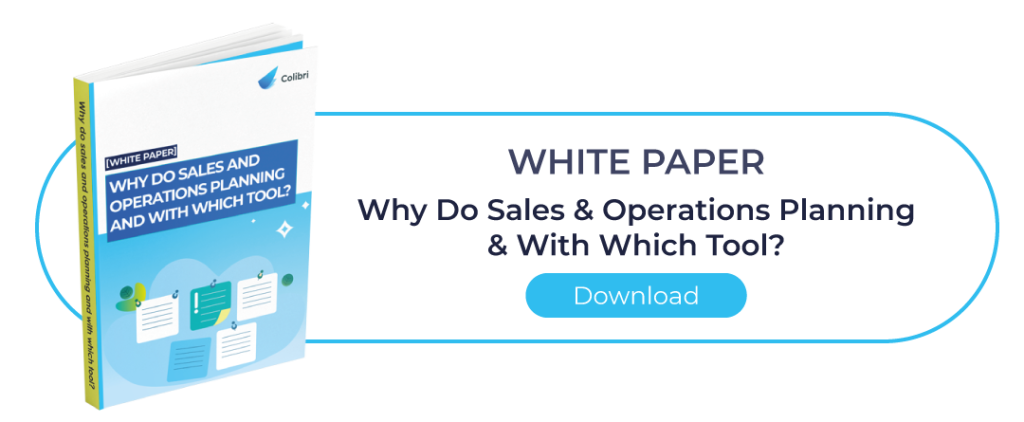Definition
Sales and operations planning (S&OP) is a process to develop tactical plans that provide management the ability to strategically direct its businesses to achieve competitive advantage. The purpose is to integrate, on a regularly basis, customer-focused marketing plans for new and existing products with the management of the supply chain.
The primary target of the S&OP process is to determine what and how much your customers are going to buy, and your capability to meet this demand. A second target of the S&OP process is to align plans with financial goals. At a minimum, this implies that financial goals may need to be revised, but there are several strategic alternatives available for the organization to increase sales or lower costs.
Sales & Operations Planning: A process that brings everyone together
The process brings together all the plans for the business (sales, marketing, development, manufacturing, sourcing, and financial) into one integrated set of plans. It is performed at least once a month and is reviewed by management at an aggregate (product family) level. The process must reconcile all supply, demand, and new-product plans at both the detail and aggregate levels and tie to the business plan. It is the definitive statement of the company’s plans for the near to intermediate future, coving a horizon long enough to plan resources and support the annual business planning process. Executed properly, the S&OP process links the strategic plan for the business with its execution and reviews performance measurements for continuous improvement.
S&OP stands for sales and operation plan and sales and operations planning at the same time. It is both a plan and the process that creates, implements, monitors, and continuously improves the plan. The S&OP process involves a series of meetings to meet a consensus. A demand and production plans that reflect the results of demand-side sensing and influencing activities and supply- and finance-side capabilities and constraints.

S&OP: a monthly process
To work properly, a process must be periodic. Each months, several meetings needs to happen in order to reach at the end on the month an S&OP plan for the considered period. This plan needs to be updated progressively depending on the meetings and the process. We suggest to follow a 5 steps process for a full and efficient Sales & Operation Planning.
The steps of the Sales & operations Planning process are:
Step 1: Marketing Review
Marketing, R&D, Procurement, Sales et Supply Chain share their inputs regarding the product portfolio and global calendar (launch, switch or substitution…)
Step 2: Demand Review
Sales and demand Planner analyze the sales forecasts suggested. Most of the time the forecasts are done by one or several demand planner using a Demand Planning tool. Those forecasts are then shared with the sales team, who, with the demand planner, build a final sales forecasts plan.
Step 3: Supply Review
Production director and manager and Supply Planner, analyze the validated forecasts regarding the production capacity, estimated stocks, HR and maintenance calendar. Production scenario are run to find the best solution allowing to produce whole or part of the demand plan shared initially.
Step 4: Reconciliation Review
Financial departments (CFO, management control), sales, marketing and Supply Chain gather to look and share about the different production and replenishment scenarios regarding the demand and budget. The scenarios are refined and valued thus showing the budget impacts.
Step 5: Management Review
General director and finance, marketing, sales production and Supply Chain directors choose the scenario to run among the different ones.
Maintain the process in time
To be efficient, this collaboratively process needs an internal leader that will organize the different meetings and ensure the global follow up over the months. Moreover, this monthly repetitive process has an impact on all the level of a company, it is necessary to involve the management to have the appropriate support.
Finally experts usually advise to use dynamics and modular reports in order to support and animate each meeting of the Sales & operation planning process. Indeed, to have a graphic view comparing different scenarios or hypothesis simplifies exchanges and allows to share information at all level, and more importantly to take the right decisions with all the data in hand.
S&OP provides the following organizational benefits:
- Link between business planning and tactics
- Opportunities to be proactive rather than reactive
- Definitive short-to medium-term plan
- Unified, cross-functional plan and process
- Bridge between customer value and supply chain efficiency
- Incentive to engage in continuous improvement
Sales & Operation Planning: key points
Like supply chain management, S&OP rests on the assumption that companies wishing to compete in the expanding global marketplace can and must break down the silo walls between functions and break through the barriers separating supply chain partners.
In fact, S&OP is intended to be a planning and controlling tool not just for manufacturing but for the entire enterprise. Breaking down those barriers, however, doesn’t always happen quickly and easily. That is why such a project must be cross-functional and supported by general management.






